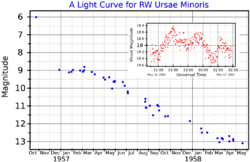Astronomy:RW Ursae Minoris
| Observation data Equinox J2000.0]] (ICRS) | |
|---|---|
| Constellation | Ursa Minor |
| Right ascension | 16h 47m 54.8186s[1] |
| Declination | +77° 02′ 12.047″[1] |
| Apparent magnitude (V) | 6 Max. >21 Min.[2] |
| Astrometry | |
| Proper motion (μ) | RA: −0.574[1] mas/yr Dec.: −1.940[1] mas/yr |
| Parallax (π) | 0.4296 ± 0.1644[1] mas |
| Distance | 2,558+2,138 −767[3] pc |
| Characteristics | |
| Variable type | classical nova |
| Other designations | |
| Database references | |
| SIMBAD | data |
RW Ursae Minoris (Nova Ursae Minoris 1956) is a cataclysmic variable star system that flared up as a nova in the constellation Ursa Minor in 1956.
Although the nova eruption of RW UMi occurred in 1956, it was not noticed until nearly six years later when, in 1962, V. Satyvaldiev found it on sky-patrol plates of the Astrophysical Institute of the Tajik Academy of Sciences in Dushanbe. On 24 September 1956 it had an apparent magnitude of 6.[7] It may have been as bright as magnitude 3.5 around 19 September 1956, which would have made it easily visible to the naked eye, but the full moon on 20 September 1956 would have hampered observations around that date.[8] RW Ursae Minoris's pre-nova brightness was about magnitude 21, but early in the 21st century it was still two magnitudes brighter than that.[6]
Novae tend to be found near the galactic plane, but RW Ursae Minoris has a galactic latitude of 33 degrees, which is far from the plane of the Milky Way. Because of this, and its large outburst amplitude, astronomers were initially unsure about whether RW Ursae Minoris was a nova in the Milky Way or a supernova in another galaxy.[7][9] It was eventually identified as a nova in the galactic halo on the basis of its light curve and spectrum.[8][10]
All novae are binary stars, with a "donor" star orbiting a white dwarf. The donor star is so close to the white dwarf that material from the donor is transferred to the white dwarf. In 1995 Retter and Lipkin detected a low amplitude (0.1 - 0.2 magnitude) variation in RW Ursae Minoris's brightness with a period of 1.4 hours. They argued that this 1.4 hour period is probably the orbital period of the binary pair, which would make it the shortest period orbit for any known nova.[11]
RW Ursae Minoris is surrounded by a small nova remnant shell. In 1985, Judith Cohen reported its radius as 1 arc second based observations with the Hale Telescope.[12] In 1995 Esenoglu et al. observed it with the Copernico 1.82 m telescope and measured a radius of ~1.5 arc seconds.[13]
References
- ↑ 1.0 1.1 1.2 1.3 1.4 Vallenari, A. et al. (2022). "Gaia Data Release 3. Summary of the content and survey properties". Astronomy & Astrophysics. doi:10.1051/0004-6361/202243940 Gaia DR3 record for this source at VizieR.
- ↑ 2.0 2.1 Schaefer, Bradley E. (2018). "The distances to Novae as seen by Gaia". Monthly Notices of the Royal Astronomical Society 481 (3): 3033–3051. doi:10.1093/mnras/sty2388. Bibcode: 2018MNRAS.481.3033S.
- ↑ Bailer-Jones, C. A. L.; Rybizki, J.; Fouesneau, M.; Demleitner, M.; Andrae, R. (2021). "Estimating Distances from Parallaxes. V. Geometric and Photogeometric Distances to 1.47 Billion Stars in Gaia Early Data Release 3". The Astronomical Journal 161 (3): 147. doi:10.3847/1538-3881/abd806. Bibcode: 2021AJ....161..147B.
- ↑ "RW Ursae Minoris". SIMBAD. Centre de données astronomiques de Strasbourg. http://simbad.u-strasbg.fr/simbad/sim-basic?Ident=RW+Ursae+Minoris.
- ↑ Ahnert, P. (January 29, 1963). "Nova Ursae Minoris 1956 (Fortsetzung)". Mitteilungen über Veränderliche Sterne. http://www.sternwarte-sonneberg.de/observatory/images/mvs/volume_01/733.png. Retrieved 26 April 2022.
- ↑ 6.0 6.1 Bianchini, A.; Tappert, C.; Canterna, R.; Tamburini, F.; Osborne, H.; Cantrell, K. (2003). "RW Ursae Minoris (1956): An Evolving Postnova System". The Publications of the Astronomical Society of the Pacific 115 (809): 811–18. doi:10.1086/376434. Bibcode: 2003PASP..115..811B.
- ↑ 7.0 7.1 Kukarkin, B.V. (December 1962). "Nova or Supernova". Information Bulletin on Variable Stars 18 (1): 1. Bibcode: 1962IBVS...18....1K. https://ui.adsabs.harvard.edu/abs/1962IBVS...18....1K. Retrieved 28 December 2020.
- ↑ 8.0 8.1 Ahnert, P. (January 1963). "Nova Ursae Minoris 1956". Information Bulletin on Variable Stars 19: 1. Bibcode: 1963IBVS...19....1A. https://ui.adsabs.harvard.edu/abs/1963IBVS...19....1A. Retrieved 28 December 2020.
- ↑ Efremov, Y.N. (January 1962). "SVS 1359 - Nova with large amplitude or supernova". Astronomicheskii Tsirkulyar 232: 2–3. Bibcode: 1962ATsir.232....2E. https://ui.adsabs.harvard.edu/abs/1962ATsir.232....2E. Retrieved 28 December 2020.
- ↑ Duerbeck, H.W. (January 1985). "Novae in the galactic halo?". Mitteilungen der Astronomischen Gesellschaft 63: 190. Bibcode: 1985MitAG..63..190D. https://ui.adsabs.harvard.edu/abs/1985MitAG..63..190D. Retrieved 28 December 2020.
- ↑ Retter, A.; Lipkin, Y. (January 2001). "The detection of a 1.4-h period in RW Ursa Minoris - candidate for shortest recorded orbital period nova". Astronomy and Astrophysics 365 (3): 508–513. doi:10.1051/0004-6361:20000150. Bibcode: 2001A&A...365..508R.
- ↑ Cohen, J.G. (May 1985). "Nova shells. II. Calibration of the distance scale using novae". The Astrophysical Journal 292: 90–103. doi:10.1086/163135. Bibcode: 1985ApJ...292...90C. https://ui.adsabs.harvard.edu/abs/1985ApJ...292...90C. Retrieved 28 December 2020.
- ↑ Esenoglu, H.H.; Saygac, A.T.; Bianchini, A.; Retter, A.; Ozkan, M.T.; Altan, M. (December 2000). "A study of RW Ursae Minoris shell". Astronomy and Astrophysics 364: 191–198. Bibcode: 2000A&A...364..191E. https://ui.adsabs.harvard.edu/abs/2000A&A...364..191E. Retrieved 28 December 2020.
 |



